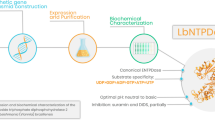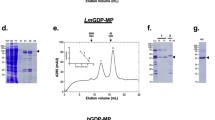Abstract
Enolase is a glycolytic and gluconeogenic enzyme also found on the surface of several eukaryotic and prokaryotic cells where it acts as plasminogen binding protein. Leishmania mexicana, one of the causative agents of Leishmaniasis, binds plasminogen and, in this parasite, enolase has been previously found associated with the external face of the plasma membrane. In this work, we show that the purified recombinant enolase has plasminogen binding activity indicating that, at the surface of the parasite, the protein may function as one of the plasminogen receptors. An internal motif 249AYDAERKMY257, similar to the nine amino-acid internal plasminogen-binding motif in Streptococcus pneumoniae enolase, is responsible for plasminogen interaction with the parasite enolase. Anti-enolase antibodies inhibited up to 60% of plasminogen binding on live parasites indicating that enolase act as a plasminogen receptor on the parasite. The fact that enolase acts as a possible plasminogen receptor in vivo makes this protein a promising target for therapy.



Similar content being viewed by others
References
Andronicos NM, Ranson M, Bognacki J, Baker MS (1997) The human ENO1 gene product (recombinant human alpha-enolase) displays characteristics required for a plasminogen binding protein. Biochim Biophys Acta 1337:27–39
Avilán L, Calcagno M, Figuera M, Lemus L, Puig J, Rodríguez AM (2000) Interaction of Leishmania mexicana promastigotes with the plasminogen-plasmin system. Mol Biochem Parasitol 110:183–193
Bergmann S, Wild D, Diekmann O, Frank R, Bracht D, Chhatwal GS, Hammerschmidt S (2003) Identification of a novel plasmin(ogen)-binding motif in surface displayed alpha-enolase of Streptococcus pneumoniae. Mol Microbiol 49:411–423
Bernal D, de la Rubia JE, Carrasco-Abad AM, Toledo R, Mas-Coma S, Marcilla A (2004) Identification of enolase as a plasminogen-binding protein in excretory–secretory products of Fasciola hepatica. FEBS Lett 563:203–206
Boyle MDP, Lottenberg R (1997) Plasminogen activation by invasive human pathogens. Thromb Haemost 77:1–10
Calcagno M, Avilán L, Colasante C, Berruela L, Salmen S (2002) Interaction of different Leishmania mexicana morphotypes with plasminogen. Parasitol Res 88:972–978
Coleman JL, Benach JL (1999) Use of the plasminogen activation system by microorganisms. J Lab Clin Med 134:567–576
Coleman JL, Gebbia JA, Piesman J, Degen JL, Bugge TH, Benach JL (1997) Plasminogen is required for efficient dissemination of B. burgdorferi in ticks and for enhancement of spirochetemia in mice. Cell 89:1111–1119
Deutsch DG, Mertz ET (1970) Plasminogen: purification from human plasma by affinity chromatography. Science 170:1095–1096
Ehinger S, Schubert WD, Bergmann S, Hammerschmidt S, Heinz DW. (2004) Plasmin(ogen)-binding alpha-enolase from Streptococcus pneumoniae: crystal structure and evaluation of plasmin(ogen)-binding sites. J Mol Biol 343:997–1005
Ge J, Catt DM, Gregory RL (2004) Streptococcus mutans surface alpha-enolase binds salivary mucin MG2 and human plasminogen. Infect Immun 72:6748–6752
Goguen JD, Bugge T, Degen JL (2000) Role of the pleiotropic effects of plasminogen deficiency in infection experiments with plasminogen-deficient mice. Methods 21:179–183
Harlow E, Lane D (1988) Antibodies. A laboratory manual. Cold Spring Harbor Laboratory, New York
Jolodar A, Fischer P, Bergmann S, Buttner DW, Hammerschmidt S, Brattig NW (2003) Molecular cloning of an alpha-enolase from the human filarial parasite Onchocerca volvulus that binds human plasminogen. Biochim Biophys Acta 1627:111–120
Jong AY, Chen SH, Stins MF, Kim KS, Tuan TL, Huang SH (2003) Binding of Candida albicans enolase to plasmin(ogen) results in enhanced invasion of human brain microvascular endothelial cells. J Med Microbiol 52:615–622
Knaust A, Weber MV, Hammerschmidt S, Bergmann S, Frosch M, Kurzai O (2007) Cytosolic proteins contribute to surface plasminogen recruitment of Neisseria meningitidis. J Bacteriol 189:3246–3255
Laemmli UK (1970) Cleavage of structural proteins during the assembly of the head of bacteriophage T4. Nature 227:680–685
Lähteenmäki K, Edelman S, Korhonen TK (2005) Bacterial metastasis: the host plasminogen system in bacterial invasion. Trends Microbiol 13:79–85
Lloyd-Williams P, Albericio F, Giralt E (1997) Chemical Approaches to the Synthesis of Peptides and Proteins. CRC, Boca Raton
Maldonado J, Calcagno M, Puig J, Maizo Z, Avilán L (2006) A study of cutaneous lesions caused by Leishmania mexicana in plasminogen-deficient mice. Exp Mol Pathol 80:289–294
Marcilla A, Perez-Garcia A, Espert A, Bernal D, Munoz-Antoli C, Esteban JG, Toledo R. (2007) Echinostoma caproni: Identification of enolase in excretory/secretory products, molecular cloning, and functional expression. Exp Parasitol (in press) DOI 10.1016/j.exppara.2007.03.011
Nakajima K, Hamanoue M, Takemoto N, Hattori T, Kato K, Kohsaka S (1994) Plasminogen binds specifically to alpha-enolase on rat neuronal plasma membrane. J Neurochem 63:2048–2057
Neshich G, Togawa RC, Mancini AL, Kuser PR, Yamagishi ME, Pappas G Jr, Torres WV, Fonseca e Campos T, Ferreira LL, Luna FM, Oliveira AG, Miura RT, Inoue MK, Horita LG, de Souza DF, Dominiquini F, Alvaro A, Lima CS, Ogawa FO, Gomes GB, Palandrani JF, dos Santos GF, de Freitas EM, Mattiuz AR, Costa IC, de Almeida CL, Souza S, Baudet C, Higa RH (2003) STING Millennium: A web-based suite of programs for comprehensive and simultaneous analysis of protein structure and sequence. Nucleic Acids Res 31:3386–3392
Nordstrand A, Shamaei-Tousi A, Ny A, Bergström S (2001) Delayed invasion of the kidney and brain by Borrelia crocidurae in plasminogen-deficient mice. Infect Immun 69:5831–5839
Pancholi V (2001) Multifunctional alpha-enolase: its role in diseases. Cell Mol Life Sci 58:902–920
Pancholi V, Fischetti VA (1998) Alpha-enolase, a novel strong plasmin(ogen) binding protein on the surface of pathogenic streptococci. J Biol Chem 273:14503–14515
Pérez H, Labrador F, Torrealba JW (1979) Variations in the response of five strains of mice to Leishmania mexicana. Int J Parasitol 9:27–32
Plow EF, Felez J, Miles LA (1991) Cellular regulation of fibrinolysis. Thromb Haemost 66:32–36
Quiñones W, Peña P, Domingo-Sananes M, Cáceres A, Michels PA, Avilán L, Concepción JL (2007) Leishmania mexicana: Molecular cloning and characterization of enolase. Exp Parasitol 116:241–51
Ramajo-Hernández A, Pérez-Sánchez R, Ramajo-Martín V, Oleaga A (2007) Schistosoma bovis: Plasminogen binding in adults and the identification of plasminogen-binding proteins from the worm tegument. Exp Parasitol 115:83–91
Redlitz A, Fowler BJ, Plow EF, Miles LA (1995) The role of an enolase-related molecule in plasminogen binding to cells. Eur J Biochem 227:407–415
Sali A, Blundell TL (1993) Comparative protein modelling by satisfaction of spatial restraints. J Mol Biol 234:779–815
Sambrook J, Fritsch EF, Maniatis T (1989) Molecular Cloning: A Laboratory Manual, 2nd edn. Cold Spring Harbor Laboratory, Cold Spring Harbor, NY
Sousa LP, Silva BM, Brasil BS, Nogueira SV, Ferreira PC, Kroon EG, Kato K, Bonjardim CA (2005) Plasminogen/plasmin regulates alpha-enolase expression through the MEK/ERK pathway. Biochem Biophys Res Commun 337:1065–1071
Sun H, Ringdahl U, Homeister JW, Fay WP, Engleberg NC, Yang AY, Rozek LS, Wang X, Sjobring U, Ginsburg D (2004) Plasminogen is a critical host pathogenicity factor for group A streptococcal infection. Science 305:1283–1286
Acknowledgments
This work was supported by CDCHT-ULA Grant C-1321-05-03B. We wish to thank Dr. Anne-Lise Haenni for critical reading of the manuscript.
Author information
Authors and Affiliations
Corresponding author
Rights and permissions
About this article
Cite this article
Vanegas, G., Quiñones, W., Carrasco-López, C. et al. Enolase as a plasminogen binding protein in Leishmania mexicana . Parasitol Res 101, 1511–1516 (2007). https://doi.org/10.1007/s00436-007-0668-7
Received:
Revised:
Accepted:
Published:
Issue Date:
DOI: https://doi.org/10.1007/s00436-007-0668-7




